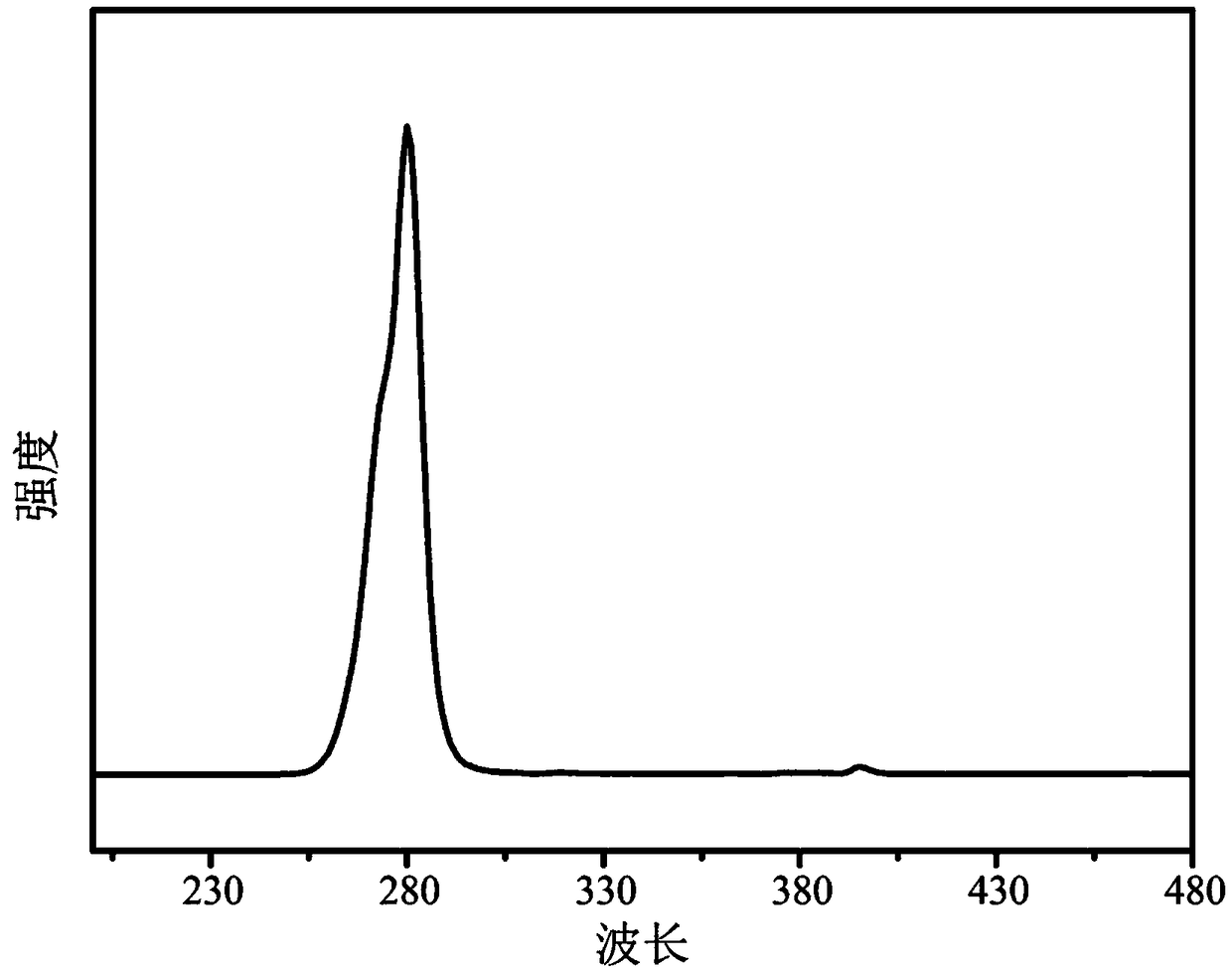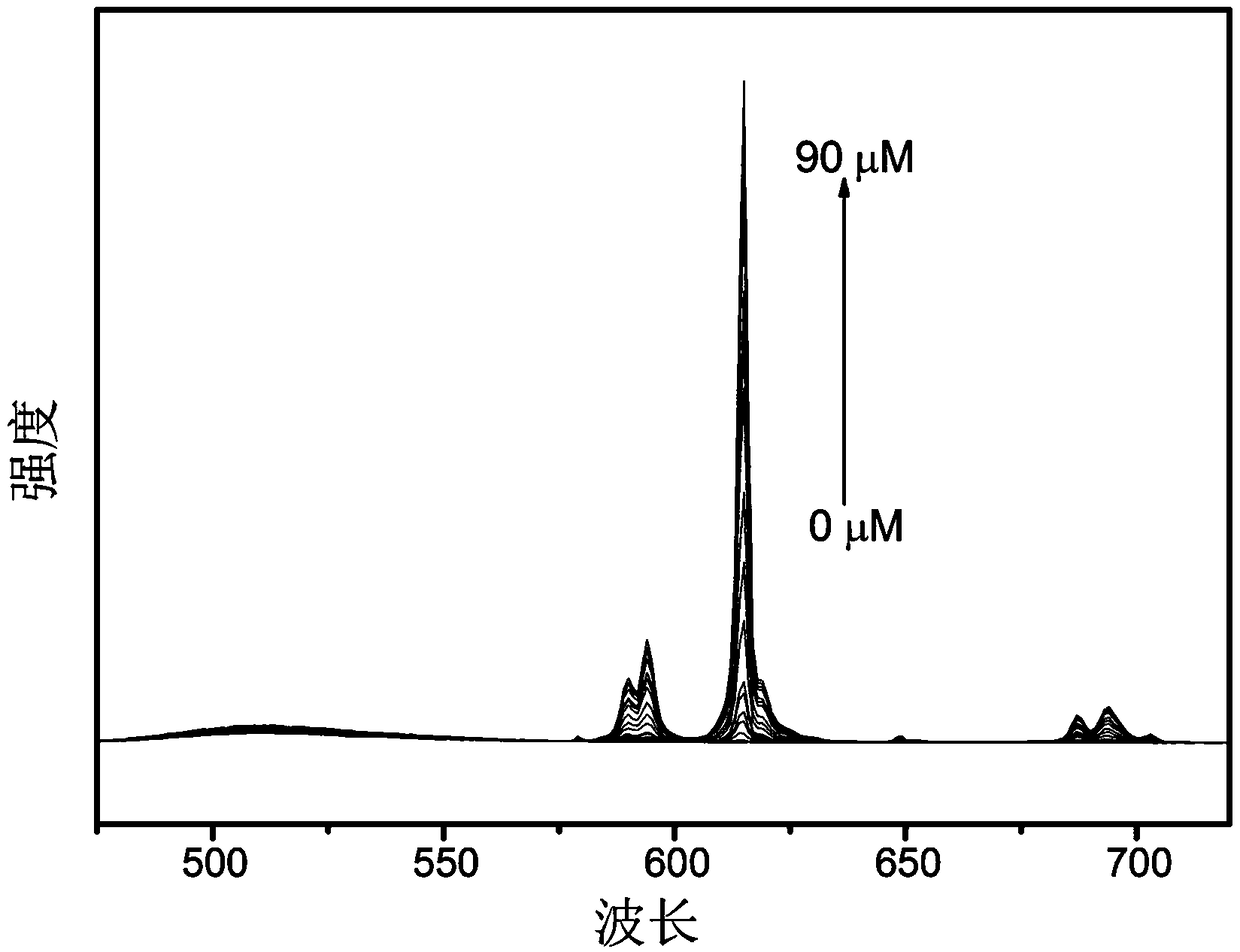Water solution for efficiently detecting Bacillus anthraci marker pyridine-2,6-dicarboxylic acid as well as preparation method and application of water solution
A technology of bacillus anthracis and dicarboxylic acid, which is applied in the direction of measuring devices, instruments, fluorescence/phosphorescence, etc., can solve the problems of long reaction cycle, high synthesis cost, cumbersome synthesis and purification steps, etc., and achieve long reaction cycle and high synthesis cost , the effect of simple method
- Summary
- Abstract
- Description
- Claims
- Application Information
AI Technical Summary
Problems solved by technology
Method used
Image
Examples
Embodiment 1
[0033] (1) Accurately weigh 15.1 mg of sodium polyacrylate (average relative molecular mass: 5,000,000 to 7,000,000) into a 100 mL beaker, add 19,600 μL of water, stir at room temperature for 50 minutes until completely dissolved without bubbles, and then add 400 μL of 0.1M EuCl 3 ·6H 2 O aqueous solution, continue stirring for 30 minutes, and record it as the main solution.
[0034] (2) Take 3mL of the main body solution in the quartz cell, add 1 μL of 1.5mM 8-hydroxypyrene-1,3,6-trisodium trisulfonate solution (at this time, the 8-hydroxypyrene-1,3,6-trisodium in the quartz cell - The concentration of trisodium trisulfonate solution is 0.5 μM) (calculated as: the mass ratio is fluorescent molecular group: rare earth ion: acrylate = 1:1160:2170, and the mass fraction of water in the solution is 99.90%), stirring Evenly, the fluorescence emission spectrum of the blank was measured 11 times at an excitation wavelength of 280nm. Add different concentrations of pyridine-2,6-dic...
Embodiment 2
[0049] (1) Accurately weigh 19.0mg of sodium polyacrylate into a 100mL beaker, add 19600μL of water, stir at room temperature for 50 minutes until completely dissolved without bubbles, and then add 400μL of 0.1M TbCl 3 Aqueous solution, continue to stir for 30 minutes, recorded as the main solution.
[0050] (2) Take 3mL of the main body solution in a quartz cell, (calculated as: the mass ratio is rare earth ion: acrylate = 100:220, the mass fraction of water in the solution is 99.90%) and stir evenly, and the excitation wavelength is 280nm Measure the fluorescence emission spectrum of the blank 11 times. Add different concentrations of pyridine-2,6-dicarboxylic acid (DPA) solutions with a 1 μL injector (fluorescence titration). The fluorescence emission spectrum is measured with 280nm as the maximum excitation wavelength and 544nm as the maximum emission wavelength.
[0051] Chart 2: As the concentration of pyridine-2,6-dicarboxylic acid aqueous solution increases, the corr...
Embodiment 3
[0062] Step (1) (2) (3) (4) is the same as embodiment 2, the TbCl in the step (1) 3 Aqueous solution changed to NdCl3 Aqueous solution, with other conditions unchanged, the identification and detection of pyridine-2,6-dicarboxylic acid were also carried out with the main solution. Under the ultraviolet light, the fluorescence brightness of the host solution has been significantly changed. The ratio of fluorescence intensity has also been greatly improved.
PUM
 Login to View More
Login to View More Abstract
Description
Claims
Application Information
 Login to View More
Login to View More - R&D
- Intellectual Property
- Life Sciences
- Materials
- Tech Scout
- Unparalleled Data Quality
- Higher Quality Content
- 60% Fewer Hallucinations
Browse by: Latest US Patents, China's latest patents, Technical Efficacy Thesaurus, Application Domain, Technology Topic, Popular Technical Reports.
© 2025 PatSnap. All rights reserved.Legal|Privacy policy|Modern Slavery Act Transparency Statement|Sitemap|About US| Contact US: help@patsnap.com



